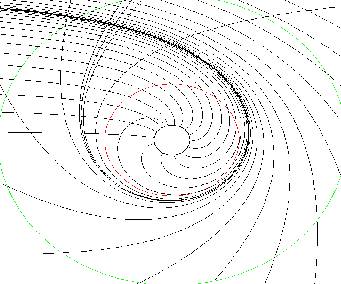Black Holes
When a star has use up all it's nuclear fuel, gravity makes it contract. The star becomes denser and the gravitational field near the star becomes more intense. The curvature of spacetime in the region of the star becomes more pronounced, and increases with the mass of the star. If the mass of the star left behind after any loss of mass due to a supernova explosion for example is bigger than about three solar masses, there is no known force than can stop the complete collapse of the star. The spacetime around the star folds up and in on itself, creating a closed off region of spacetime. Nothing from inside this region can escape – not even light, though material and light may still fall into the hole. A black hole has been created, with the entire mass of the star concentrated at a point called a singularity.
Any light passing near the hole is made to follow a curve path by the intense curvature of spacetime. Some such are shown below.

As the black hole is approached the gravitational forces and the tidal forces – the difference between the gravitational force of your head and your feet – both increase, causing you to be 'spaghettified'. At some point you will pass through the photon sphere – a thin shell of photons orbiting the hole. As the distance from the black hole decreases, the force of gravity increases and the escape velocity increases. At some distance from the singularity, the escape velocity will equal the speed of light. At this distance, the kinetic energy of a body able to escape will be equal in magnitude to the gravitational potential energy.
![]()
![]()
The radius above is called the Scharzschild radius. It produces a shell around the hole called the event horizon. The event horizon forms the surface of the hole. Anything passing inside the event horizon cannot escape the hole, and is doomed to meet the singularity.
A black hole the mass of the Sun has a Schwarzschild radius of![]()